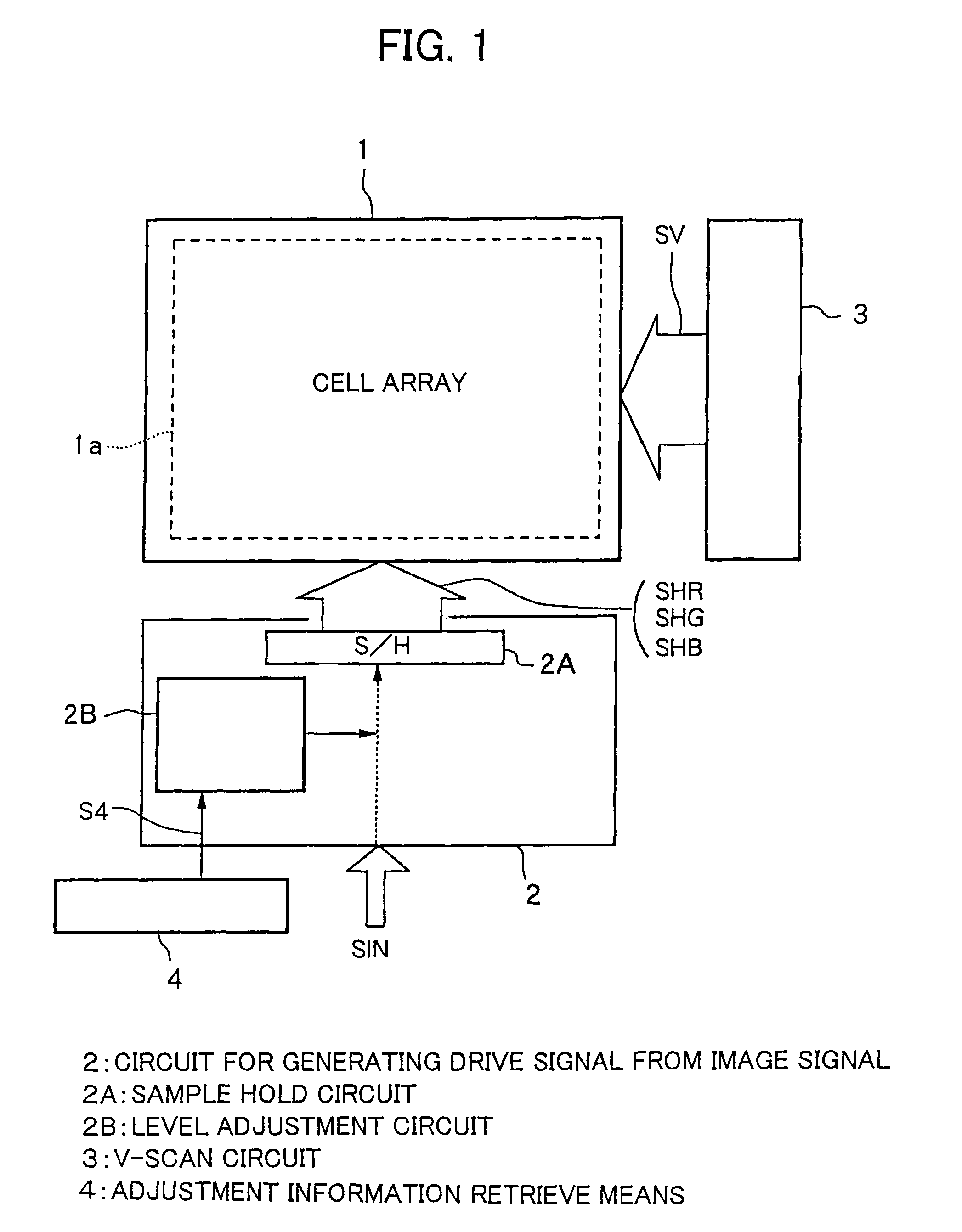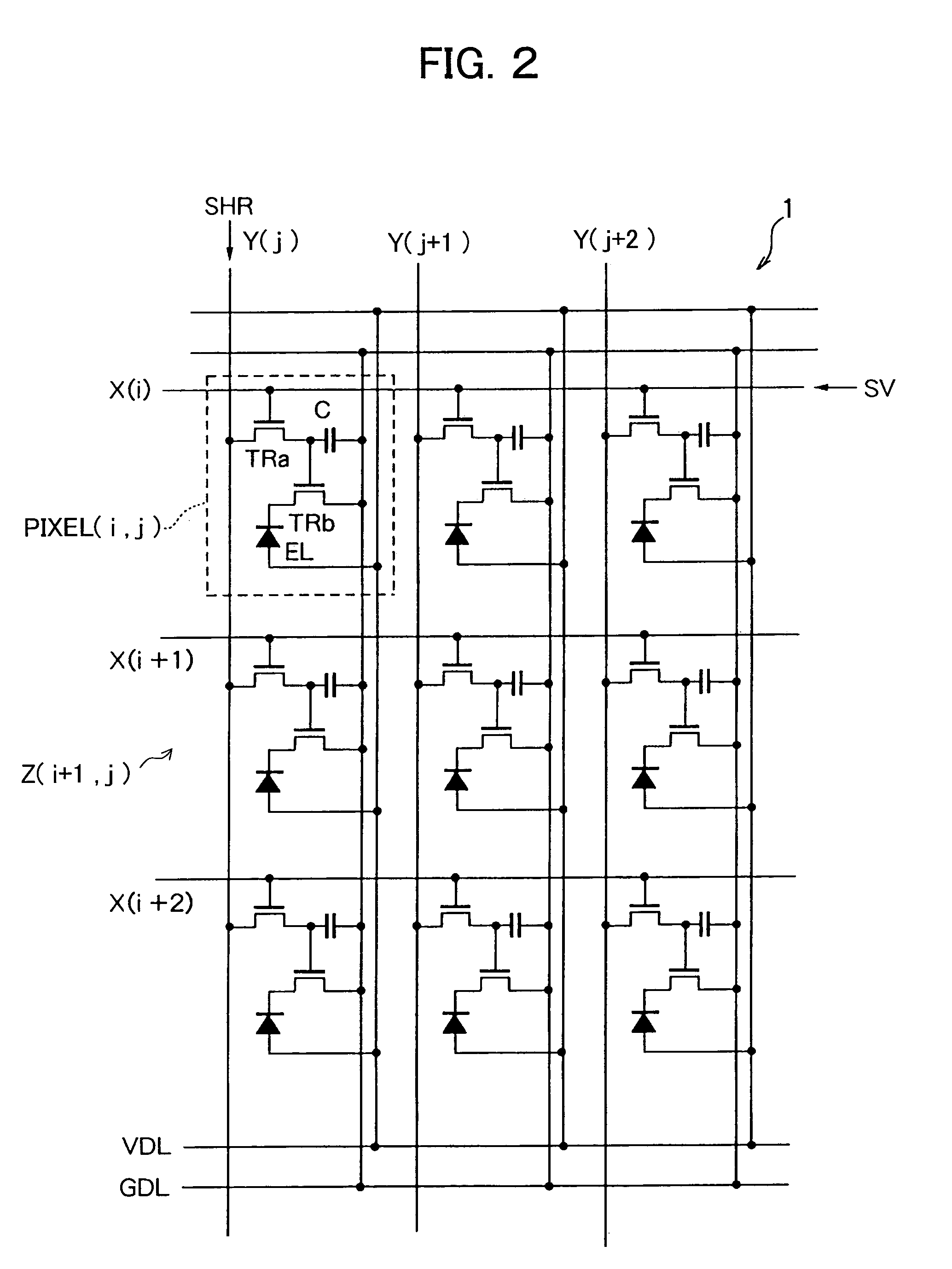Image display device and the color balance adjustment method
a color balance and display device technology, applied in static indicating devices, instruments, electroluminescent light sources, etc., can solve the problems of image quality change, poor contrast, and difficulty in balancing both at high levels, and achieve the effect of easy adjustment of color balan
- Summary
- Abstract
- Description
- Claims
- Application Information
AI Technical Summary
Benefits of technology
Problems solved by technology
Method used
Image
Examples
first embodiment
[0051]FIG. 1 is a block diagram showing the configuration of an organic EL display device of the present embodiment. FIG. 2 is a circuit diagram showing the configuration of pixels of the present embodiment.
[0052]The display device illustrated in FIG. 1 comprises a cell array 1 wherein a large number of pixels including an organic EL element provided at each of cross points of a plurality of scan lines in the line direction and a plurality of data lines in the column direction are arranged in a matrix in a predetermined color arrangement, and a signal processing and data line drive circuit 2 connected to data lines in accordance with an input address signal, for performing necessary signal processing on an input image signal and supplying to the data lines of the cell array 1.
[0053]Also, the display device comprises a scan line drive (V-scan) circuit 3 connected to the scan lines, for applying a scan signal SV to scan lines at a predetermined period.
[0054]In the cell array 1 shown i...
second embodiment
[0062]In the second embodiment, a detailed configuration of a display device and a method of adjusting color balance fluctuated when produced will be explained.
[0063]FIG. 3 is a block diagram of a display device showing a detailed configuration example of the configuration in FIG. 1.
[0064]In the display device shown in FIG. 3, a sample hold circuit 2A for generating a data line drive signal and a V-scan circuit 3 are provided inside a display panel 10 together with the cell array 1. A signal processing circuit 22 and a driver IC are provided on a circuit substrate outside of the display panel 10.
[0065]The signal processing circuit 22 performs necessary digital signal processing, such as, resolution conversion, IP (Interlace-Progressive) conversion and noise removal, on an input image signal SIN.
[0066]The driver IC converts an image signal (digital signal) after signal processing to an analog signal and performs parallel-serial conversion. A serial-analog RGB signal after the convers...
third embodiment
[0099]In the third embodiment, potential of an anode or a cathode of an organic EL element (hereinafter, referred to as an EL voltage) is detected, and a suitable drive voltage for each of the RGB signals based on the result is output. The detection result of the EL voltage corresponds to “information relating to light emission adjustment” in the first embodiment. Since it is possible to always monitor this information, luminance of the respective RGB colors can be automatically corrected in accordance with changes of characteristics of the organic EL element over time.
[0100]Below, the third embodiment will be explained by taking as an example the case of detecting an anode voltage of organic EL elements and automatically correcting changes over time based on the result.
[0101]Since organic EL elements are self-luminous elements, the luminance declines due to thermal fatigue of the organic multilayer body when emitting light at high luminance for a long time.
[0102]FIG. 10 is a graph ...
PUM
 Login to View More
Login to View More Abstract
Description
Claims
Application Information
 Login to View More
Login to View More - R&D
- Intellectual Property
- Life Sciences
- Materials
- Tech Scout
- Unparalleled Data Quality
- Higher Quality Content
- 60% Fewer Hallucinations
Browse by: Latest US Patents, China's latest patents, Technical Efficacy Thesaurus, Application Domain, Technology Topic, Popular Technical Reports.
© 2025 PatSnap. All rights reserved.Legal|Privacy policy|Modern Slavery Act Transparency Statement|Sitemap|About US| Contact US: help@patsnap.com



